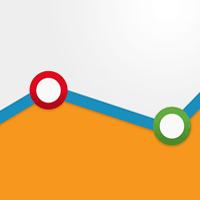Gaining Fluency in Web Analytics

In early 2017, IDC forecasted worldwide revenues for big data and business analytics would grow from $130.1 billion in 2016 to more than $203 billion in 2020 - at a compound growth rate of 11.7 percent. While the bright future of this vital digital industry segment is reason enough to improve analytics fluency, the impact that doing so can have on an enterprise's own success makes regular exploration a necessity.
The trouble today, however, has not only been the complexity of implementing and managing an analytics initiative, but also the rich diversity of opportunities available to help Web professionals aggregate, analyze and report on any manner of data and the impact as well.
In this month's feature article at Website Magazine, increase your familiarity with the wide variety of analytics types and explore ways to use available systems to improve key indicators of digital performance.
The Value Proposition
The abundance of data available today has brightened the horizons for data analysts. Once a relatively thankless position, today's data analysts are the virtual rock stars of their respective enterprises and they are getting paid handsomely for their expertise. The average annual salary for an analytics manager, for example, is $105,909 and demand for these professionals is only increasing by the day (Burning Glass Technologies, 2017).
There are obviously great benefits to those enterprises employing data analysts. Insights into customer behaviors, evaluations of the quality of the experience, and social trends are just some of what is available by employing the solutions and the analysts who share the insights enterprises require to optimize campaigns and maximize customer value.
Analytics are meant to provide insights into how a digital experience helps users satisfy their needs (whether informational or transactional), but it is quite common to stumble on the path toward not only fluency, but also excellence and refinement in the process.
The Big Analytics Missteps
The most significant misstep taken by those looking to use data analytics initiatives to gain access to information that delivers actionable insights and provides a competitive edge is in the failure to identify and choose the most appropriate form. Wait, aren't all analytics the same? Not exactly.
Successful data analysts have the ability (and experience) to know which kind of analytics data is going to be most appropriate in a particular situation. For example, there are descriptive analytics, predictive analytics and even prescriptive analytics. Failure to realize these are interrelated results in a poor-performing data analytics initiative and disastrous effects for the enterprise. Let's explore these different types of analytics and what they offer the modern enterprise.
Descriptive analysis summarizes raw data and makes it easily understandable by humans. This form of analytics uses past events as its foundation and provides analysts with insights into how they might influence future outcomes. Enterprises must use descriptive analysis when they want to understand, at an aggregate level, what is going on with their audience in relation to the digital experience being provided. Within the sales cycle, for example, descriptive analytics can be used to categorize customers by their likely product or content preferences.
Predictive analysis is about understanding the future, providing estimates of the likelihood of outcomes. While no system can (yet) predict exactly what is going to happen in the future (at least not with any accuracy), enterprises can use this data to forecast what might happen and base their strategies on probabilities rather than history. Many companies use predictive analytics for lead scoring, analyzing source, number and type of communications, social media, existing customer relationship management data, etc. Prescriptive analysis aims to guide users to an actual solution for some existing problem, not only identifying the issue and predicting what will happen, but also suggesting different possible actions to implement-providing a plan that will move the enterprise toward a more engaging experience for users and a more profitable one for enterprises.
Prescriptive analytics systems essentially suggest the best course of action using a combination of techniques and tools such as business rules, algorithms, machine learning and computational modelling procedures. Social media management solutions such as Hootsuite, for example, suggest the optimal times for sending messages on Facebook or Twitter.
Most analytics system/solutions/platforms-any offering that makes it possible to analyze data-provide one (and often more) of the different types of analytics. Ultimately, the different types of analytics are most useful when they are combined and can complement each other, which makes choosing the optimal solution so essential.
The purpose of addressing the different types of analytics is this: it is important to know what an analytics system is capable of so the right decision can be made in relation to its selection. Before looking at a few of the leading analytics solutions available for Web professionals today and exploring some practical use cases to consider for implementation, now would be a good time to shift your thinking about analytics and what should be measured in the first place.
Shift Analytics
Thinking One of the main problems with analytics solutions today is they simply are not being used in the right way. It is not uncommon to track specific metrics such as unique visitors per channel or sales value per source, but why not shift thinking to consider how analytics can be applied more broadly (while answering the same question).
With so much data at analysts' disposal it is easy to become overwhelmed and lose sight of what is truly important. The "pirate" metrics, however, provide a useful framework to gain greater clarity into the performance of digital initiatives from the first touch to the last (acquisition, activation, retention, referral, revenue - or "AARRR," like a pirate). Learn more about these pirate metrics .
Keep in mind there are many underlying metrics, but looking at the AARRR metrics (in context) provide a basic but strong understanding of where improvement is possible and opportunities abound for growth.
Types of Analytics Solutions
Too often Web professionals get stuck using standard (sometimes rudimentary) descriptive analytics solutions that do little more than report on common metrics like unique visitors, page views or time on site. There are, fortunately, many interesting analytics solutions emerging that could get serious 'Net professionals much closer to accurately identifying performance and positioning themselves to accelerate for digital success.
Intelligence
Machine learning and artificial intelligence (AI) are already significant drivers of progress made in the analytics industry. For millions of Web professionals, however, their solutions are about to get way smarter. Google, for example, is rolling out a feature enabling users to ask questions in order to get relevant answers about their Google Analytics account.
The newly available ability to ask questions of data is part of Google's Analytics Intelligence, a set of features using machine learning to help businesses better understand and act on their data-generating smart lists, smart goals and evaluating session quality in the process.
The addition of "intelligence" of this nature takes an enterprise's analytics initiative from the descriptive to the prescriptive, and Google's solution and the many others entering the market have a lot of data to work with - some of which is poised to have a dramatic effect on the digital industry.
Voice Analytics
Adobe's Analytics Cloud offering, for example, is now able to track the performance of voice-enabled intelligence assistants such as Alexa, Siri, Google Home and Cortana among others.
While this is the company's first foray into voice analytics and helping brands get a better handle on conversational computing, improvements in speech recognition and the corresponding increased adoption among consumers have made the opportunity far too important to ignore apparently.
Both Amazon and Google have provided some means to understand consumer activity on these devices for some time (although it has been somewhat limited). In April 2017, for example, Amazon began offering voice analytics, and Google is recommending developers consider the use of voice analytics startup VoiceLabs.
Adobe Analytics Cloud, however, is taking voice analytics to another level entirely, providing the ability to combine datasets and track customers across multiple devices (e.g., from Alexa to offline actions). This functionality dramatically increases the likelihood of being able to intelligently track consumers and improve the quality of insights these voice-activated assistants (and behaviors and activity upon them) can provide.
Adobe's solution will make it possible to track user ID, intent, number of users, number of sessions, session length, frequency of use and error rate (which, if you are using Alexa in my house, is pretty high).
Ultimately, our "machines" will be able to tell us a lot about the experience of users, and it will be the responsibility of those fluent in the language of analytics to help shape the future.
Cognitive Computing
For the most part 'Net professionals do a rather excellent job taking advantage of descriptive and even predictive analytics. Where it tends to fall apart is when it comes to the more sophisticated prescriptive analysis, made possible of late only thanks to dramatic improvements to cognitive computing.
Cognitive technologies (e.g., cognitive computing) provide an opportunity to understand and reason vast amounts of both structured and unstructured data (including sound and images) in much the same way humans do - through reasoning, learning and interaction.
Despite the possibilities, nearly two-thirds (64 percent) of chief marketing officers (CMOs) and sales leaders believe their industries will be ready to adopt "cognitive" technologies in the next three years according to the new IBM Institute for Business Value (IBV) study, "From data deluge to intelligent insights: Adopting cognitive computing to unlock value for marketing and sales."
While both CMOs and heads of sales agree "customer satisfaction" is the number one value driver for adopting cognitive solutions, many of those executives surveyed say they are not sure their organizations are currently set up to make a successful transition.
Where traditional analytics can provide data for businesses to draw insights from, cognitive computing such as IBM Watson can more easily predict outcomes and turn those insights into actionable recommendations, which can impact real business decisions. The problem, as illustrated in the IBM survey, is only 24 percent of those chief marketing officers and sales leaders surveyed believe they have a strategy in place to implement these technologies today.
For surveyed CMOs, they expect the real advantage of cognitive lies in two key areas: improved customer experience and financial results - including increased financial yields and improved ability to identify marketing ROI.
Business and financial use cases are not the only use of predictive analytics, of course; it is also being used in the realm of digital advertising as well.
Big data analytics solution IRI recently partnered with Pinterest, for example, to enable the companies to better measure advertising campaigns in order to create a lift in sales for brands leveraging the platform.
The new IRI Lift for Pinterest solution will integrate Pinterest's advertising exposure data with IRI's big data assets to link advertising exposure on Pinterest to actual offline purchases, both on Pinterest itself and on other platforms (as far down as the specific product and household levels).
The result is marketing analytics will be able to see campaign analytics with reportedly 80 percent more accurate results and be able to use the information to adjust campaigns to deliver relevant messaging to their consumers. The solution will also enable measurement of engagement via loyalty and lifetime value analytics as well as analysis of Pinterest KPIs like pins, pin close-ups, pin click-throughs, repins, time spent and number of visits for a deeper understanding of sales performance and its drivers.
The Path toward Analytics Fluency
There is more data available now than ever before and more strategies and software to analyze said data. While the sheer amount of data can feel overwhelming to under-prepared enterprises and the marketers they employ, those who know what they need from an analytics initiative, know how to get there (by using the right type of solution) and know the right solutions to choose (like those mentioned in this month's "Top50 Analytics Solutions for 'Net Pros") are those best positioned on the path toward analytics fluency and a more profitable enterprise in the short and long term.









